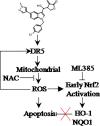LCT-3d Induces Oxidative Stress-Mediated Apoptosis by Upregulating Death Receptor 5 in Gastric Cancer Cells
- PMID: 33937072
- PMCID: PMC8085419
- DOI: 10.3389/fonc.2021.658608
LCT-3d Induces Oxidative Stress-Mediated Apoptosis by Upregulating Death Receptor 5 in Gastric Cancer Cells
Erratum in
-
Corrigendum: LCT-3d induces oxidative stress-mediated apoptosis by upregulating death receptor 5 in gastric cancer cells.Front Oncol. 2025 May 29;15:1590809. doi: 10.3389/fonc.2025.1590809. eCollection 2025. Front Oncol. 2025. PMID: 40510138 Free PMC article.
Abstract
Gastric cancer is a global health problem. In this study, we investigate the role of a novel Indole derivative, named LCT-3d, in inhibiting the growth of gastric cancer cells by MTT assay. The Western blotting results showed that LCT-3d modulated the mitochondrial-related proteins and Cleaved-Caspases 3/9, to induce cell apoptosis. The up-regulation of Death receptor 5 (DR5) in MGC803 cells was observed with LCT-3d treatment. Knockdown of DR5 on MGC803 cells partially reversed the LCT-3d-induced mitochondrial apoptosis. The level of Reactive Oxygen Species (ROS) in MGC803 cells was increased with LCT-3d treatment and could be blocked with the pretreatment of the ROS inhibitor N-Acetylcysteine (NAC). The results demonstrate that the elevating ROS can up-regulate the expression of DR5, resulting in apoptosis via mitochondrial pathway. Although the nuclear factor erythroid-2 related factor 2 (Nrf2) pathway served an important role in protecting gastric cancer cells against the injury of ROS, it can't reverse LCT-3d-induced cell apoptosis. Taken together, our study showed that LCT-3d induced apoptosis via DR5-mediated mitochondrial apoptotic pathway in gastric cancer cells. LCT-3d could be a novel lead compound for development of anti-cancer activity in gastric cancer.
Keywords: DR5; LCT-3d; Nrf2; apoptosis; gastric cancer; reactive oxygen species.
Copyright © 2021 Wang, Wu, Yu, Hu, Li, Meng, Lv, Kim, Choi, Wang, Xu and Jin.
Conflict of interest statement
The authors declare that the research was conducted in the absence of any commercial or financial relationships that could be construed as a potential conflict of interest. The reviewer JH declared a shared affiliation with one of the authors, G-YK, to the handling editor at time of review.
Figures







Similar articles
-
Perillaldehyde synergizes with ferroptosis inducers to promote ferroptotic cell death in gastric cancer.Front Cell Dev Biol. 2025 Jun 3;13:1598520. doi: 10.3389/fcell.2025.1598520. eCollection 2025. Front Cell Dev Biol. 2025. PMID: 40530331 Free PMC article.
-
A systematic review of p53 regulation of oxidative stress in skeletal muscle.Redox Rep. 2018 Dec;23(1):100-117. doi: 10.1080/13510002.2017.1416773. Epub 2018 Jan 3. Redox Rep. 2018. PMID: 29298131 Free PMC article.
-
A novel 2-oxopyrrolidine derivative (LN-53) efficiently induces Nrf-2 signaling pathway activation in human epidermal keratinocytes.Pharmacol Rep. 2025 Jun 24. doi: 10.1007/s43440-025-00757-y. Online ahead of print. Pharmacol Rep. 2025. PMID: 40553247
-
Yttrium oxide nanoparticles induce selective cytotoxicity, genomic instability and ROS mitochondrial P53 mediated apoptosis in human pancreatic cancer cells.Sci Rep. 2025 Jun 20;15(1):20144. doi: 10.1038/s41598-025-05088-9. Sci Rep. 2025. PMID: 40542009 Free PMC article.
-
Cost-effectiveness of using prognostic information to select women with breast cancer for adjuvant systemic therapy.Health Technol Assess. 2006 Sep;10(34):iii-iv, ix-xi, 1-204. doi: 10.3310/hta10340. Health Technol Assess. 2006. PMID: 16959170
Cited by
-
The minimal membrane requirements for BAX-induced pore opening upon exposure to oxidative stress.Biophys J. 2024 Oct 15;123(20):3519-3532. doi: 10.1016/j.bpj.2024.08.017. Epub 2024 Aug 26. Biophys J. 2024. PMID: 39188056 Free PMC article.
-
Cell death affecting the progression of gastric cancer.Cell Death Discov. 2022 Aug 29;8(1):377. doi: 10.1038/s41420-022-01161-8. Cell Death Discov. 2022. PMID: 36038533 Free PMC article. Review.
References
-
- Shen X, Wang J, Yan X, Ren X, Wang F, Chen X, et al. Predictive value of GSTP1 Ile105Val polymorphism in clinical outcomes of chemotherapy in gastric and colorectal cancers: a systematic review and meta-analysis. Cancer Chemother Pharmacol (2016) 77:1285–302. 10.1007/s00280-016-3047-1 - DOI - PubMed
LinkOut - more resources
Full Text Sources
Other Literature Sources

